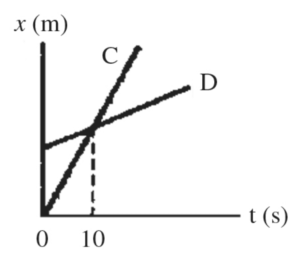A planet of constant mass orbits the sun in an elliptical orbit. Neglecting any friction effects, what happens to the planet’s rotational kinetic energy about the sun’s center?
A projectile is launched at a speed of \( 22 \) \( \text{m/s} \) at an angle of \( 60^{\circ} \) above the horizontal. It lands on a ramp that is \( 5 \) \( \text{m} \) lower than the launch height. How long does it take for the projectile to hit the ramp?
A car with speed \( v \) and an identical car with speed \( 3v \) both travel the same circular section of an unbanked (flat) road. If the frictional force required to keep the faster car on the road without skidding is \( F \), then the frictional force required to keep the slower car on the road without skidding is

A small block moving with a constant speed v collides inelastically with a block M attached to one end of a spring k. The other end of the spring is connected to a stationary wall. Ignore friction between the blocks and the surface.

The figure shows a graph of the position x of two cars, C and D, as a function of time t. According to this graph, which statements about these cars must be true? (There could be more
than one correct choice.)
When the speed of a rear-wheel-drive car is increasing on a horizontal road, what is the direction of the frictional force on the tires?
A \(30 \, \text{g}\) bullet is fired with a speed of \(500 \, \text{m/s}\) into a wall.
A 3800 kg open railroad car coasts along with a constant speed of 8.60 m/s along a level track. Snow begins to fall vertically and fills the car at rate of 3.50 kg/min. Ignoring friction with the tracks, what is the speed of the car after 90 min?
A 2,000 kg car collides with a stationary 1,000 kg car. Afterwards, they slide 6 m before coming to a stop. The coefficient of friction between the tires and the road is 0.7. Find the initial velocity of the 2,000 kg car before the collision?
Two balls are thrown off a building with the same speed, one straight up and one at a 45° angle. Which statement is true if air resistance can be ignored?
Find the downward acceleration of an elevator, given that the ratio of a person’s stationary weight to their weight in the elevator is \(5:4\).
By continuing you (1) agree to our Terms of Use and Terms of Sale and (2) consent to sharing your IP and browser information used by this site’s security protocols as outlined in our Privacy Policy.
Quick Start Guide
AP physics 1, AP C, honors and advanced physics students.
Quickly filter questions by units and more.


Here’s guide to using 5 UBQ filters.
GQ = general question, MCQ = multiple choice, FRQ = free response.


Click the check or bookmark button.
Now you’ll be able to see completed or bookmarked questions at a glance!
Answer keys, personalized for you.

Phy will be responsible for grading your FRQs and GQs.
No more copy and pasting. Just solve and snap.
Questions for Mastery

By continuing you agree to nerd-notes.com Terms of Service, Privacy Policy, and our usage of user data.